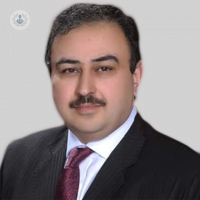Stress fractures of the foot : Part one
Written in association with:We can all be affected by stress fractures, from professional athletes to office workers we are all susceptible to this kind of injury. Read on for consultant orthopaedic surgeon Mr Turab Syed’s expert opinion on stress fractures and why they have been on the rise during the COVID-19 pandemic.

What is a stress fracture?
A stress fracture is a common injury that patients describe as a gradually worsening pain in a certain part of the body, that cannot be attributed to a particular incident. They are also known as “fatigue fractures” and the most common cause is repeated overuse. The commonly affected areas to be affected by stress fractures in the foot & ankle are the metatarsal, navicular, the base of the second metatarsal, medial malleolus, and the fifth metatarsal base. They can occur in different parts of the body such as one’s feet (30%), tibia (38%) and fibula (11%).
Stress fractures typically happen when someone starts a new activity or sport and does too much too soon, rather than gradually increasing their levels of intensity and time of activity. Training surfaces like cambered or uneven surfaces increase the risk of stress fractures as ground reactions forces are increased. Some of you may remember that at this year’s Olympics in Japan they had a newer surface for athletics to reduce the ground reaction forces and such stress fractures.
They are often known as “military fractures” or “march fractures” due to their prevalence in new army recruits. This group are particularly susceptible due to the intensity of the training and marching that they have to take part in
Why has the rate of stress fractures increased since the start of the COVID-19 pandemic?
There are multiple factors that have led to the increase in stress fracture cases during the pandemic, but the main one is the lockdown measures that have been enforced. The closure of gyms, sports clubs and swimming pools led many people to take up new exercise routines and try activities that their bodies weren’t used to. For example, someone who regularly swam before the pandemic but decided to take up running because all of the swimming pools were closed could be susceptible to stress fractures.
Why are stress fractures so common in feet?
Simply put, the main reason stress fractures are so common in the feet is their complicated construction, each foot consists of 26 bones and even more joints, each of different sizes and different ranges of motion and flexibility. The foot can be horizontally divided into three parts, known as rays; the medial ray, which is the big toe section, the middle ray, which includes the second and third toe section and the lateral ray, which is the part where the fourth and fifth toes are. Stress fractures most commonly occur in the shaft of the middle ray due to it being the most rigid, particularly near the ankle. On rare occasions, they can also occur further down, near the toes, which typically takes longer to heal.
While stress fractures can also occur in the medial or lateral rays, they are much less likely because those rays are much more flexible and mobile than the middle one. Biomechanical abnormalities also predispose one to stress fractures. These abnormalities not only concentrate stresses at specific areas of bone but also result in muscle fatigue.
Some other intrinsic factors can make you more suscetible, including:
- Cavus feet (which can cause stress fractures of the fifth Metatarsal)
- Leg length discrepancies
- Excessive fore foot varus (where the tip of the foot is turned inwards)
- Tarsal coalition (bones are joined together congenitally)
- Prominent calcaneum/heel bone
- Tight heel cords / tight Achilles
- Osteoporosis
Are stress fractures more common in some sports?
Yes. Stress fractures have different rates in different sports due to demands placed on foot & tibia with these activities are different. For example, stress fractures are common in long distance runners / marathon trainers, followed by sprinters and ball games then jumping and power events. They are rarely seen in skiing and orienteering.
Regarding tibial stress fractures they are again most common in long distance running, followed equally by ball games and skiing, followed by power events, and sprinting but rarely seen in jumping or orienteering except for proximal tibia which has the highest rate of stress fractures in orienteering.
Check out part two of this article series, where Mr Syed takes us through the symptoms, diagnosis and treatment of stress fractures of the foot.
If you think you might be suffering from a stress fracture you should seek the advice of an orthopaedic specialist. Visit Mr Turab Syed’s Top Doctors profile, where you can request an appointment with him.


